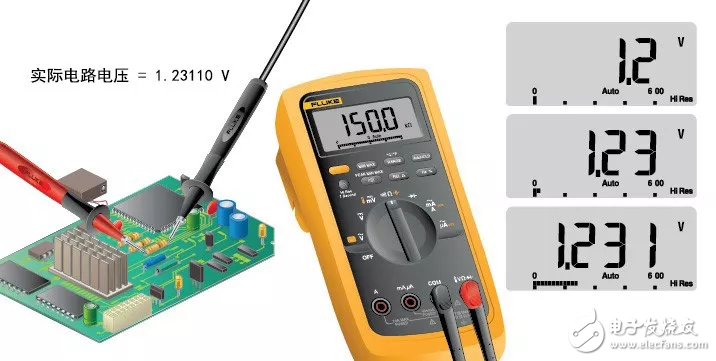A text to understand the concept of measuring instrument accuracy, resolution, range, accuracy
Accuracy: The accuracy of the instrument—the proximity of its measured value to the true or reference value of the signal being measured.
Resolution: The smallest increment the instrument can detect and display—one hundredth, one thousandth, one millionth.
Range: The upper and lower limits of the value or signal that the instrument can measure (eg, amps, volts, and ohms).
Accuracy: Repeatability of the instrument – ​​the reliability of the same measurements is continuously reproduced.

Accuracy refers to the maximum allowable error under certain operating conditions.
Accuracy is expressed as a percentage and refers to the proximity of the displayed measured value to the true value (standard value) of the measured signal. Accuracy requirements are compared to recognized industry standards.
The accuracy of a particular DMM is not exactly the same, depending on the application. For example, most AC grid voltage changes are ±5% or greater. Measuring the voltage at a standard AC 115 V power outlet is the range of this variation. If a digital multimeter is only used to check if the outlet has power, a digital multimeter with a measurement accuracy of ±3% is appropriate.
Some applications, such as calibration of automobiles, medical aviation or specialized industrial equipment, may require higher accuracy. If the accuracy of the DMM is ±2%, the possible range for reading 100.0 V is 98.0 V to 102.0 V. This is fine for some applications, but is unacceptable for sensitive electronic devices.
Accuracy may also be the addition of a number (word) to the basic accuracy indicator. For example, ±(2%+2) accuracy means that if the multimeter reads 100.0 V, it may range from 97.8 V to 102.2 V. Higher accuracy digital multimeters can support more applications.
The basic DC accuracy of the Fluke handheld multimeter is 0.5% to 0.025%.
ResolutionResolution is the smallest increment the tool can detect and display.
Two rulers are used as examples of non-electrical measurement tools. For a ruler with a 1/16-inch scale and another ruler with a 1/4-inch scale, the former has a higher resolution.
Take the test of a 1.5 V household battery as an example. If the digital multimeter (DMM) has a resolution of 1 mV at 3 V, a 1 mV change may be observed at 1 V reading. The user is able to observe a change of one thousandth of a volt, ie 0.001.
The resolution may be listed as the maximum resolution in the meter's specifications, which is the minimum value that can be resolved at the meter's lowest range setting.
For example, if the maximum resolution is 100 mV (0.1 V), it means that when the multimeter's range is set to measure the highest possible voltage, the voltage will be displayed to the nearest tenth of a volt.
As long as the measured value is within the range, the resolution can be increased by lowering the range setting of the digital multimeter.

Motorola Radio,Motorola Two Way Radios,Motorola Talkabout Radios,Motorola Handheld Radio
Guangzhou Etmy Technology Co., Ltd. , https://www.digitaltalkie.com
